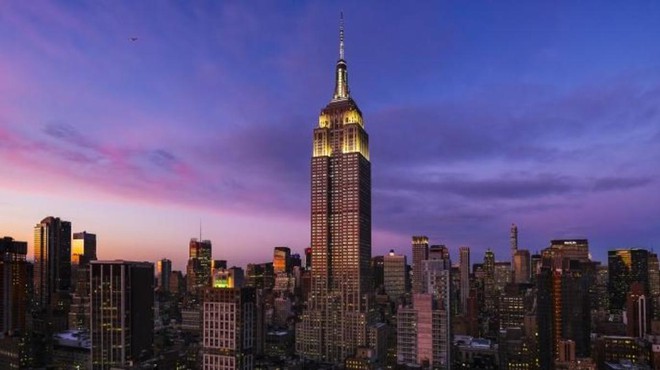The symbol of America – the Empire State Building is operating entirely on wind power
- Tram Ho
On Wednesday, the company that owns the Empire State Building announced it had signed an agreement to switch to wind power to operate not only this building but also other buildings they run.
Accordingly, the Midtown building, along with 13 other buildings owned by the Empire State Realty Trust, will only use wind power through a three-year power purchase agreement – this turns the ESRT back on. to become a renewable electricity user that is among the largest commercial real estate in the US. It is known that the Empire State building itself has been operating on renewable energy for a decade.
Switching to wind power will reduce carbon dioxide by 204 million kilograms, the equivalent of emissions from all taxis in New York in a year, according to the company. The decision comes after the building management announced the replacement of all the window lights and crowns with LED lights, thereby reducing carbon emissions by 40%, last year.
” We continue our commitment to reducing our environmental impact, ” said Dana Robbins Schneider, Vice President and Director of Energy and Sustainability at ESRT. ” Our clients will now work in carbon-free offices, and the investment community can follow the path we pioneered. ”
Buying clean electricity does not mean getting electricity directly from certain wind turbines located outside the city. In fact, the contracts signed with Green Mountain Energy and Direct Energy contain terms that require these two service providers to ensure the same amount of electricity as the Empire State building and other buildings in the agreement. used will be produced from wind somewhere in the US. Even so, this is still a very significant statement.
” Driving the real estate community to a zero-emission future requires owners of famous buildings, like the Empire State Building, to take first steps and inspire others ” – Cara Carmichael Says the Rocky Mountain Institute’s Emission Building Program director. ” The Empire State Building has always been a symbol in New York, and a leader in real estate technology. Now, they are taking the lead in the energy sector. ”

Reducing carbon emissions in buildings is one of the next decade’s tough tasks, especially in older buildings like the Empire State. Cities around the world are gradually introducing measures to ban the use of gas systems in newly built buildings, thereby reducing emissions. Installing more efficient appliances, windows, doors, and lights is another solution to reducing emissions, and can be done easily in newer buildings. But the number of old buildings, already built in the past, that need this solution to be implemented, is enormous. An estimated 5.6 million commercial buildings and tens of millions of residential buildings require rapid “blood transfusions” to minimize the worst effects of the environmental crisis. Globally, carbon emissions from buildings have soared in 2019 and account for 38% of total emissions.
The switch to wind power by the Empire State building has created a positive role model and a (small) step in implementing environmental pollution reduction policies. But those policies have opened up many avenues for other buildings to follow. At the city level, New York has issued a requirement to force buildings to cut emissions by 40% by 2030. Buildings here have a much larger carbon footprint than global buildings. – more than 70% of New York City’s carbon emissions come from buildings – and stricter emissions standards will help address this biggest source of pollution. These policies, along with seeing the Empire State building shift to clean energy, will be the driving force for the New York real estate industry to follow.
“The transition to emissions-free buildings requires a combination of market institutions and government policies, ” says Carmichael. ” Local policies can have some impact, but if we are to achieve the already difficult goal of reducing carbon emissions then government intervention is needed. ”
Reportedly, US President Joe Biden also recently signed a number of decrees aimed at reducing emissions from federal buildings. By taking measures to reduce carbon emissions in federal infrastructure and capitalizing on the financial resources of the federal government, the ordinance can help lower the costs of low-emission building materials. or air emissions, thereby disseminating them to the community. The ordinance also includes the creation of the Climate Conservation Corps with the aim of ” enhancing the resilience of the community “. Building weather-proof buildings and installing solar power systems on the community and household scale is certainly an effective way to achieve that goal and reduce emissions.
Reference: Gizmodo
Source : Genk
